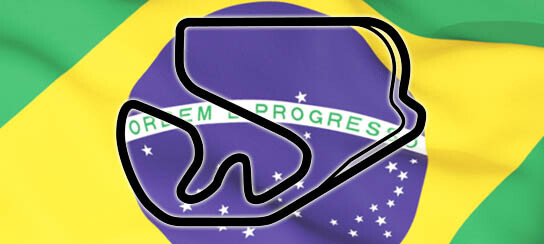BIOGRAPHY
The name Interlagos comes from the Portuguese for 'between the lakes' because the circuit was built in a natural bowl which had two small lakes in it. Indeed, they partly dictated the layout of the original 4.496-miletrack which was unusual in that it twisted in on itself.
It was built in 1954 close to Sao Paolo, Ayrton Senna's home city and though it had a winding layout, it had a wide range of corners, some very demanding indeed.
Interlagos hosted the Brazilian GP from the first non-Championship race in 1972 to 1980, with the exception of 1978 when Rio de Janeiro held the race.
In 1980, the first corner, Curva 1, which was one of the great bends on the Formula One calendar, was tightened and then the Brazilian GP went to Rio de Janeiro until 1989.
The race returned to Interlagos in 1990 with a new layout which retained the old section on both sides of the start/finish line. The infield kept the character of the original, but lap distance was shortened from 4.946 miles to 2.687 miles. Naturally, one of the new bends was named 'Senna's'.
Since 1985, the official name of the circuit has been the Autodromo Jose Carlos Pace in memory of the brilliant Brazilian who, in 1975, scored the only Grand Prix win of his brief career at Interlagos.
Popular with fans, Interlagos is also loved by drivers who consider it challenging due to its various undulations which make it harder to drive and demand more power from the car's engines.
The circuit is also known for its bumpy surface, which takes its toll on the cars due to their low ride height and minimal suspension travel.
Tough on the car, the circuit is also tough on the drivers, especially since the race is run anti-clockwise, where the centrifugal forces in the many hard left turns push the drivers' necks to the right, instead of left as in the majority of circuits on the F1 calendar.
For the 2007 Grand Prix, the most sweeping repair programme of the last 35 years was carried out, mainly to solve the problems with the track surface. The existing asphalt was entirely replaced resulting in a much smoother track surface. At the same time, the pit lane entrance was enhanced to improve safety and a new fixed grand stand added.
Ahead of the 2011 Grand Prix, FIA race director Charlie Whiting detailed several planned upgrades of the circuit, including a new pit entrance and expanded run-off at the final corner, as a response to several fatal accidents at the circuit that same year.
In June 2012, further details of the proposed plans emerged, calling for the construction of a brand new pit building and the relocation of the start line from its current position between Arquibancadas and the Senna 'S' to Reta Oposta.
In July 2013, approval was given for a major overhaul of the circuit's facilities following continued criticism from Bernie Ecclestone. In addition to the new pit and paddock complex, sections of the track are to be "realigned" along with plans for a new media centre, podium, VIP enclosure and FIA control room. The final phase of the overhaul should be ready in time for the 2016 race.
Fast Facts - Provided by the FIA
2018 marked the 46th Brazilian Grand Prix. The race has been of the F1 calendar annually since 1973. After five events in Sao Paulo, the race moved to Rio's Jacarepagua circuit in 1978, returned to Interlagos in 1979 and 1980 before move to Rio between 1981-1989. The event returned to Interlagos in 1990 and has been held here since.
Alain Prost is the most successful driver at the Brazilian Grand Prix with six wins (1982, 1984, 1985, 1987, 1988, 1990). All but the last of Prost's wins were scored at Jacarepagua. The most successful driver at Interlagos is Michael Schumacher with four wins at the Sao Paulo track.
McLaren are the most successful team with 12 wins. Ferrari are next on the lost with 10 victories. The two teams, however, are tied on eight victories each at Interlagos.
Just three drivers have taken a first career win in Brazil, with all being scored here at Interlagos: Brazil's Carlos Pace won for the first time and only time in 1975, driving for Brabham. Frenchman René Arnoux scored the first of seven career wins here in 1980 with Renault, while the most recent first-time winner is Italy's Giancarlo Fisichella in 2003, though due to confusion over he result in a chaotic, rain-shortened finish , he had to wait several days before being declared winner.
Five drivers have visited the podium for the first time in Brazil: Jochen Mass (P3, 1975); Elio de Angelis (P2, 1980); Mauricio Gugelmin (P3, 1989); Damon Hill (P2, 1993), and Nick Heidfeld (P3, 2001). Heidfeld's 2001 podium was the beginning of his march to an F1 record he undoubtedly wishes he no longer held - that of driver with the most podium finishes without a win. Nick has 13.
Nico Hulkenberg landed the one and only pole position of his career to date at Interlagos in 2010. Only two other drivers have secured a maiden pole position at the Brazilian GP: Ronnie Peterson (1973), and James Hunt (1976).


